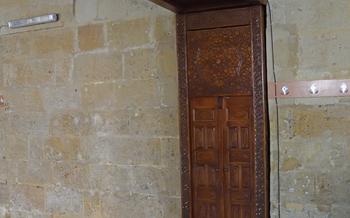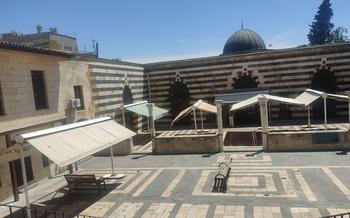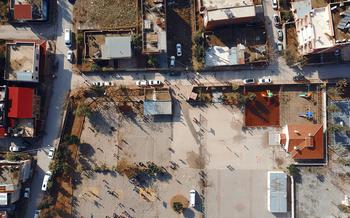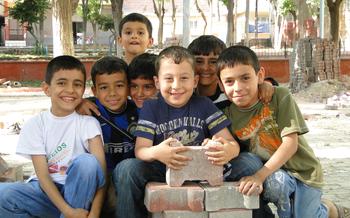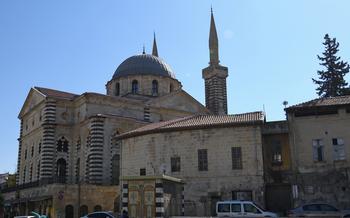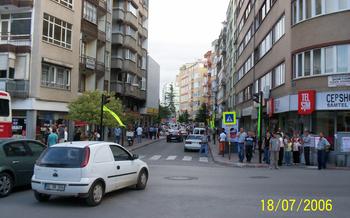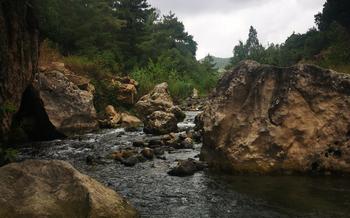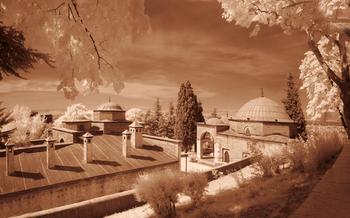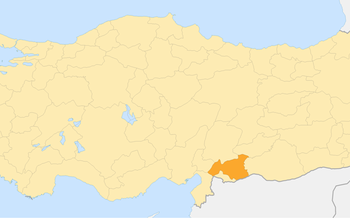
Kurtulus Camii Mosque
- The Antiquity of Gaziantep's Great Mosque
- A Journey Through Time: Exploring the Mosque's History
- Architectural Marvel: Unveiling the Mosque's Design
- A Place of Worship and Community
- Cultural Significance: The Mosque as a Symbol of Gaziantep
- Imamzadeh Mausoleum: A Hidden Gem Within the Mosque:
- Prayer Hall Serenity: A Sanctuary for Reflection
- Courtyard Oasis: A Place for Contemplation and Gathering
- Minaret Majesty: A Symbol of Faith and Guidance
- Historical Significance: A Witness to Gaziantep's Past
- Local Traditions: Unveiling Gaziantep's Cultural Heritage
- Restoration Efforts: Preserving a Legacy
- Accessibility and Facilities: Welcoming Visitors
- Photography and Videography: Capturing the Mosque's Beauty
- Insider Tip: Discovering Hidden Gems
The Antiquity of Gaziantep's Great Mosque
The Kurtulus Camii Mosque stands as a testament to Gaziantep's rich history and cultural heritage. Built during the Mamluk period in the 13th century, the mosque has witnessed the rise and fall of empires, the ebb and flow of civilizations, and the transformation of Gaziantep from a humble settlement to a vibrant metropolis. Its enduring presence speaks to the resilience and continuity that have characterized this ancient city.
The mosque's architectural style reflects the Mamluk influence of the time, characterized by intricate stonework, elegant arches, and a distinctive minaret. Its imposing facade and spacious courtyard exude an aura of grandeur and spirituality, inviting visitors to step into a realm of tranquility and devotion. As one of the oldest and most significant mosques in Gaziantep, the Kurtulus Camii holds a special place in the hearts of the city's inhabitants, serving as a place of worship, a center of community, and a symbol of their enduring faith.
In my travels to Gaziantep, I had the privilege of visiting the Kurtulus Camii Mosque. As I stepped through its ancient gates, I was struck by a sense of awe and reverence. The intricate carvings that adorned the walls, the soft light filtering through the stained-glass windows, and the melodious sound of prayers echoing through the courtyard created an atmosphere of serenity and spirituality that left an indelible mark on my soul.
A Journey Through Time: Exploring the Mosque's History
The Kurtulus Camii Mosque stands as a testament to the rich history of Gaziantep, embodying the city's resilience and cultural heritage. Constructed during the Mamluk period in the 13th century, the mosque has undergone numerous renovations and additions over the centuries, reflecting the city's evolving architectural styles and cultural influences.
Despite facing historical challenges, including wars and natural disasters, the mosque has endured and remains a significant landmark in Gaziantep. Its longevity is a testament to the dedication and craftsmanship of its builders, as well as the enduring faith and devotion of the local community.
Intriguing stories and legends surround the mosque's past, adding to its mystique and allure. One tale speaks of a hidden underground tunnel that once connected the mosque to other parts of the city, serving as a secret passage during times of conflict. Another legend tells of a miraculous event where the mosque's minaret miraculously survived a powerful earthquake, symbolizing the mosque's divine protection and resilience.
Architectural Marvel: Unveiling the Mosque's Design
The Kurtulus Camii Mosque stands as a testament to the architectural prowess of its era. Its exterior boasts impressive stonework, intricately carved with geometric patterns and verses from the Quran. The mosque's distinctive minaret, adorned with intricate tilework and topped with a conical roof, is a striking landmark that can be seen from various parts of the city. The mosque's spacious courtyard, with its lush greenery and serene atmosphere, provides a tranquil oasis amidst the bustling city.
Upon entering the mosque, visitors are greeted by a breathtaking prayer hall. The hall's vast expanse is supported by rows of elegant columns, each topped with ornate capitals. The walls are adorned with intricate tilework, featuring vibrant shades of blue, green, and gold. The ceiling is a masterpiece of craftsmanship, showcasing a mesmerizing array of patterns and motifs. The overall effect is one of awe-inspiring beauty and grandeur.
Personal Impression: As an architecture enthusiast, I was particularly drawn to the mosque's intricate details. The play of light and shadow on the carved stone surfaces created a mesmerizing effect, and the harmony between the different architectural elements was simply stunning. The mosque's design is a testament to the skill and artistry of the Mamluk builders and continues to inspire admiration to this day.
A Place of Worship and Community
The Kurtulus Camii Mosque is not merely a historical monument; it is a vibrant center of worship and community interaction. The mosque's vast prayer hall hosts daily prayers, attended by throngs of devout Muslims who come together to fulfill their religious obligations. The atmosphere during these prayers is one of profound spirituality, as worshippers immerse themselves in the sacred rituals, their voices harmoniously reciting verses from the Holy Quran.
Beyond the daily prayers, the mosque also plays a crucial role in fostering a sense of community among the people of Gaziantep. It serves as a gathering place for social and cultural events, where locals come together to celebrate religious holidays, organize educational programs, and engage in discussions about faith and contemporary issues. The mosque's courtyard, with its tranquil ambiance and lush greenery, provides a welcoming space for community members to socialize, exchange ideas, and strengthen their bonds.
Cultural Significance: The Mosque as a Symbol of Gaziantep
The Kurtulus Camii Mosque stands as a proud representation of Gaziantep's rich cultural heritage, embodying the city's unique blend of history, religion, and traditions. Its inclusion in the city's tourism routes and cultural events highlights its significance as a must-see destination for visitors seeking an immersive cultural experience. The mosque serves as a bridge between the past and the present, showcasing the enduring legacy of Gaziantep's architectural and cultural achievements.
Beyond its religious significance, the mosque plays a vital role in promoting interfaith dialogue and understanding. Welcoming visitors from diverse backgrounds, the mosque encourages respectful conversations and fosters a sense of unity and harmony among people of different faiths. Through its educational programs and community outreach initiatives, the mosque actively contributes to building bridges of understanding and promoting peaceful coexistence.
As a symbol of Gaziantep's cultural identity, the Kurtulus Camii Mosque inspires a deep sense of pride and belonging among the local community. Its presence evokes a nostalgic connection to the city's past while simultaneously representing its vibrant present. The mosque's cultural significance extends far beyond its physical structure, as it serves as a living testament to the enduring spirit and cultural resilience of Gaziantep.
Imamzadeh Mausoleum: A Hidden Gem Within the Mosque:
Enclosed within the sacred grounds of the Kurtulus Camii Mosque lies a hidden gem—the Imamzadeh Mausoleum. Steeped in history and exuding an aura of reverence, this mausoleum is a testament to the spiritual significance of the mosque. Constructed in the 14th century, the mausoleum is believed to be the resting place of a revered religious figure, adding to its spiritual allure.
With its intricate stonework and elegant carvings, the Imamzadeh Mausoleum stands as a testament to the exceptional craftsmanship of its era. Its interior is adorned with exquisite tilework and calligraphy, creating a serene and contemplative atmosphere. Visitors to the mausoleum can pay their respects and seek blessings, adding a layer of spirituality to their visit to the mosque.
Whether you're a history buff, a religious pilgrim, or simply an admirer of beautiful architecture, the Imamzadeh Mausoleum is a must-visit within the Kurtulus Camii Mosque. Its unique atmosphere and historical significance make it a hidden gem that should not be missed.
Prayer Hall Serenity: A Sanctuary for Reflection
Stepping into the prayer hall of the Kurtulus Camii Mosque is like entering a sanctuary of peace and spirituality. The vast space is adorned with intricate designs and decorations, creating a mesmerizing ambiance that invites contemplation and reflection. The harmonious blend of colors and patterns evokes a sense of serenity, enveloping visitors in a tranquil embrace.
The prayer hall's high ceiling and arched windows allow natural light to filter in, casting a warm glow that illuminates the intricate details of the interior. The soft echoes of footsteps on the carpeted floor add to the serene atmosphere, creating a sense of reverence and respect.
As visitors settle into a meditative state, they can't help but be drawn to the intricate designs that adorn the walls and ceiling. Floral motifs, geometric patterns, and calligraphy inscriptions intertwine harmoniously, creating a visual feast that captivates the senses. The mihrab, the niche indicating the direction of Mecca, stands as the focal point of the prayer hall, adorned with exquisite tile work and intricate carvings.
Whether visitors are devout Muslims seeking a place of worship or travelers seeking a moment of tranquility, the prayer hall of the Kurtulus Camii Mosque offers a sanctuary for reflection and spiritual connection. It is a space where the soul can find solace, and the mind can find clarity amidst the bustling city.
Courtyard Oasis: A Place for Contemplation and Gathering
Step into the mosque's courtyard, and you'll be greeted by an oasis of serenity amidst the bustling city. Lush greenery carpets the ground, creating a verdant haven that invites contemplation and relaxation. Fountains trickle gently, their soothing sounds adding to the peaceful ambiance. Seating areas scattered throughout the courtyard provide inviting spots to sit, reflect, or simply soak in the tranquil atmosphere.
During the day, the courtyard buzzes with activity as worshippers and visitors gather to socialize and exchange stories. The air fills with laughter, conversation, and the gentle hum of community. As the sun begins to set, the courtyard transforms into a magical space, bathed in a warm, golden glow. The sound of the evening call to prayer echoes through the air, casting a spellbinding aura over the serene surroundings.
Whether you seek a moment of solitude or a chance to connect with the local community, the mosque's courtyard offers a welcoming embrace. It's a place where time seems to slow down, where worries melt away, and where the spirit finds solace and rejuvenation.
Minaret Majesty: A Symbol of Faith and Guidance
The Kurtulus Camii Mosque's towering minaret is a striking architectural feat that commands attention from afar. Its intricate stonework and elegant design reflect the mosque's overall grandeur. As the tallest structure in the vicinity, the minaret serves as a beacon of faith and guidance for the Muslim community. Its presence reminds believers of the call to prayer, echoing through the streets of Gaziantep five times a day.
The minaret's intricate carvings and patterns showcase the exceptional craftsmanship of its builders. Each level of the minaret features unique designs, creating a harmonious visual experience. The minaret's slender form tapers gracefully towards the sky, emphasizing its height and majesty.
From the top of the minaret, one can enjoy breathtaking views of Gaziantep and its surrounding landscapes. The city's rooftops, bustling streets, and distant hills unfold like a tapestry, revealing the vibrant energy of this historic city. The minaret's vantage point also offers a unique perspective on the mosque's courtyard, allowing visitors to appreciate its serene atmosphere and intricate details.
Whether viewed from afar or up close, the Kurtulus Camii Mosque's minaret is a symbol of faith and guidance. Its presence serves as a reminder of the mosque's enduring legacy and its significance as a spiritual and cultural landmark in Gaziantep.
Historical Significance: A Witness to Gaziantep's Past
The Kurtulus Camii Mosque stands as a testament to Gaziantep's rich and storied past. Its endurance through various historical events and changes makes it a living witness to the city's transformation over time. The mosque has borne witness to the rise and fall of empires, the ebb and flow of civilizations, and the many cultural influences that have shaped Gaziantep into the vibrant city it is today. Its very existence serves as a reminder of the city's resilience and adaptability, and its ability to preserve its unique identity amidst the tides of history.
As visitors walk through the mosque's ancient gates, they are transported back in time, surrounded by centuries-old architecture and steeped in the atmosphere of a bygone era. The mosque's walls whisper tales of the past, echoing with the prayers and supplications of generations of worshippers who have sought solace and guidance within its sacred walls. It is a place where history comes alive, inviting visitors to contemplate the passage of time and the enduring legacy of this remarkable city.
Local Traditions: Unveiling Gaziantep's Cultural Heritage
The Kurtulus Camii Mosque stands as a testament to Gaziantep's rich cultural heritage, playing a pivotal role in showcasing local traditions and customs. The mosque hosts various cultural events and celebrations throughout the year, immersing visitors in the vibrant tapestry of Gaziantep's unique identity. During religious festivals and holidays, the mosque becomes a hub of activity, with special prayers, ceremonies, and communal gatherings taking place within its sacred walls.
One of the most captivating traditions associated with the mosque is the annual "Hıdırellez" celebration, a springtime festival that marks the arrival of spring and the renewal of nature. During this joyous occasion, locals gather in the mosque's courtyard, adorned with colorful decorations and fragrant flowers. They engage in traditional dances, sing folk songs, and share delicious treats, creating an atmosphere of camaraderie and celebration.
The mosque also serves as a venue for traditional Islamic ceremonies such as weddings and circumcisions. These events are steeped in centuries-old customs and rituals, showcasing the deep-rooted religious and cultural practices of the local community. Visitors are welcome to witness these ceremonies, gaining insights into the rich tapestry of Gaziantep's cultural heritage.
By actively participating in these local traditions and events, visitors can gain a deeper understanding of Gaziantep's vibrant culture and the enduring legacy of the Kurtulus Camii Mosque.
Restoration Efforts: Preserving a Legacy
The Kurtulus Camii Mosque has undergone several restoration projects over the years, demonstrating the community's commitment to preserving its historical and architectural integrity. These efforts aim to maintain the mosque's authenticity while ensuring its structural stability and safety for visitors.
One of the most significant challenges faced during restoration is balancing the need for preservation with the integration of modern amenities. The mosque's caretakers have carefully considered how to incorporate features such as lighting, ventilation, and accessibility without compromising the mosque's original design.
Despite the challenges, the restoration efforts have been successful in maintaining the mosque's historical charm while enhancing its functionality. The mosque's intricate carvings, colorful tiles, and majestic minaret have been carefully restored to their former glory, ensuring that this architectural masterpiece continues to stand as a testament to Gaziantep's rich heritage.
The preservation of the Kurtulus Camii Mosque is a testament to the community's deep respect for its history and culture. By investing in restoration projects, the mosque's caretakers are ensuring that this iconic landmark will continue to inspire and captivate visitors for generations to come.
Accessibility and Facilities: Welcoming Visitors
The Kurtulus Camii Mosque is committed to welcoming visitors from all backgrounds, ensuring that everyone has the opportunity to explore and appreciate its historical and spiritual significance. The mosque provides guided tours in multiple languages, allowing visitors to gain insights into its architecture, history, and religious practices. Informative brochures and prayer mats are also available, catering to the needs of both Muslim and non-Muslim visitors.
To ensure a respectful and enriching experience, visitors are encouraged to dress modestly and observe local customs. The mosque has designated areas for men and women, and visitors are requested to adhere to these guidelines. It is also important to maintain silence and refrain from disturbing ongoing prayers or religious ceremonies.
The mosque's surroundings offer a variety of amenities, including cafes, restaurants, and shops, providing visitors with opportunities to relax, refresh, and immerse themselves in the local culture. Whether you are a history buff, a spiritual seeker, or simply a curious traveler, the Kurtulus Camii Mosque welcomes you with open arms, inviting you to discover its beauty, history, and significance.
Photography and Videography: Capturing the Mosque's Beauty
The Kurtulus Camii Mosque offers a stunning backdrop for photography and videography enthusiasts. The mosque's intricate architecture, beautiful courtyard, and serene atmosphere make it a popular subject for photographers and videographers alike. However, it's important to remember that the mosque is an active place of worship, and visitors should be respectful of the worshippers and the sanctity of the space.
Photography and videography are generally permitted within the mosque, but visitors should be mindful of the following guidelines:
-
Obtain permission: Before taking any photos or videos, it's essential to obtain permission from the mosque's authorities or guides. This ensures that you won't disturb any religious observances or ceremonies that may be taking place.
-
Be discreet: When taking photos or videos, try to be as discreet as possible. Avoid using flash photography, as this can be disruptive to worshippers.
-
Respectful angles: When photographing or filming the mosque's interior, be sure to avoid capturing images of worshippers in prayer or other private moments.
-
Tripods and equipment: Using tripods or other photography equipment is generally allowed, but it's important to be mindful of the space and not obstruct the movement of worshippers.
By following these guidelines, photographers and videographers can capture the beauty of the Kurtulus Camii Mosque while respecting the sanctity of the space and the privacy of its worshippers.
Insider Tip: Discovering Hidden Gems
Beyond its renowned architectural beauty, the Kurtulus Camii Mosque offers hidden gems that await curious explorers. Venture into the mosque's serene courtyard and discover a secluded fountain nestled amidst lush greenery, a tranquil oasis perfect for contemplation. Observe the intricate carvings adorning the fountain, each stroke telling a story of Gaziantep's rich past.
Take a moment to explore the surrounding neighborhood, where you'll find a treasure trove of hidden delights. Just a stone's throw from the mosque, stumble upon quaint local eateries serving mouthwatering kebabs and traditional Turkish cuisine. Immerse yourself in the vibrant atmosphere of the neighborhood bazaar, where vendors display an array of colorful textiles, handmade crafts, and aromatic spices.
For a glimpse into Gaziantep's rich history, venture to the nearby Zeugma Mosaic Museum, home to an awe-inspiring collection of ancient Roman mosaics that transport you back in time. Discover the stories depicted in these intricate artworks, showcasing scenes from mythology, daily life, and historical events.
As you wander through the neighborhood, engage with the friendly locals who are always eager to share stories and insights about their beloved city. Embrace the opportunity to immerse yourself in the local culture and traditions, creating lasting memories that extend far beyond the mosque's walls.
